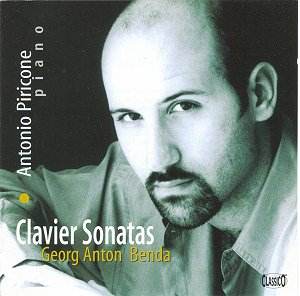Comparison recording:
Benda, 6 harpsichord sonatas, Tamara
Franzová. Supraphon SU 3745-2
131
J.C.Mann, 6 harpsichord Sonatas, R.
E. Simpson, harpsichord (2) Initium
CD A001/2
I recently
reviewed a CD of Benda keyboard
sonatas played on the harpsichord by
Tamara Franzová; that disk contains
only two of these 1757 sonatas, so if
you are a Benda completist you will
need both disks.
Benda was born in N.E.
Bohemia, and his father was a weaver
and folk musician. Georg Benda got a
good local education then emigrated
with his family in 1742 to Berlin where
he joined his older brother Frantisek
in the violin section of the Prussian
court opera orchestra. In 1750 he became
Kapellmeister in Gotha where, in addition
to the usual composing of all kinds
of church and secular music for all
combinations of instruments, he also
achieved distinction as a writer of
melodramas, two of which were in Mozart’s
personal library. He failed to obtain
an appointment in Vienna in 1778, and
retired to study and compose in the
town of Köstritz in Saxony.
These sonatas resemble
the harpsichord sonatas of Johann Christoph
Mann (1726 - 1782). Note that the two
men were born within two years of each
other. Both were active in the same
general area of Europe, Mann a native
Austrian based in Vienna but spending
much time in Bohemia. Both wrote clearly
in a North European pre-classical style
in three movements, both wrote for harpsichord
as well as fortepiano, and both men
in their music set out to entertain,
writing in a variety of forms and utilising
songs (Mann uses a Scottish folk song
in his fourth sonata), dances, and even
operatic style settings. Benda is rather
serious; Mann has more fun with his
music. Although Benda was a friend of
C.P.E. Bach, his music resembles that
of the older man only slightly. C.P.E.
Bach’s keyboard music tended to be stiff,
conservative, and somewhat ungracious,
whereas both Benda and Mann wrote very
floridly and eloquently with bold harmonic
colour. The interesting fact is that
the pre-Classical period was more experimental
harmonically than the Classical period
and it is not until Chopin and Schumann
that you see bolder harmonies.
And both composers
are not well known to modern audiences,
yet hearing their music, will teach
you quite a bit about the evolution
of German and Viennese Classical keyboard
style. Some of these movements are almost
pure Bach, some almost pure Mozart,
and there are just hints of Beethoven
and of Domenico Scarlatti here and there.
J.C. Mann used to be
frequently confused with G.M. Monn (1717-1750),
but Simpson’s research has established
their separate identities, although
they may have been brothers. Simpson
uses an electronically sampled MIDI
two manual harpsichord for his Mann
recordings. All the artists use equal
temperament tuning which most people
will probably feel is appropriate, although
I take exception to that and am convinced
that unequal temperament was very much
in use on keyboard instruments even
after 1800. And all the artists use
excellent judgement in ornamentation
— neither too much nor too little. The
performers must receive credit for this
since, although I have not seen the
scores to the Benda, this music is too
early for the ornaments to have been
written out for them in detail. Piricone
receives clear, close recording, and
he does not make use of octave doubling
or register shifts into keyboard ranges
not notated by the composer. Simpson’s
recorded sound is very close, live,
and dynamic, and he makes judicious
use of the coupled 16 foot rank.
Antonio Piricone, who
is equally renowned as a conductor and
a harpsichordist, includes a thoughtful
essay defending his decision to use
a modern piano for this recording, however
such pleading is hardly necessary. After
only a few bars one is with him all
the way. Piricone’s piano style is clear,
graceful, and non-percussive when that
is called for, yet he plays with drama
and incisiveness when appropriate; we
are not surprised to note that he has
also recorded Bach on the piano to critical
acclaim. With so many really fine recordings
of Domenico Scarlatti on the grand piano
(and perhaps a few real clunkers) the
point should have been made well enough
by now that the interpretative skill
and musical intelligence count for more
than the actual instrument at hand.
And any reasonably aware musician must
have realised that any keyboard music
he wrote after 1750 would end up played
on a pianoforte whether he intended
that or not. Interestingly, Piricone
plays some earlier works than Franzová,
yet both instruments sound equally fitting
to the music. Perhaps because we are
as used to Scarlatti on the grand piano
as on the harpsichord, Piricone’s use
of the piano has the effect of emphasising
the similarities in Benda’s style to
that of Scarlatti, but those similarities
are few. Benda was absolutely his own
man.
There is no information
either in the disk notes nor on the
Piricone’s website listing his teachers;
perhaps like Godowsky (and me) he is
self taught. Simpson studied with Paul
Nettl at Indiana University, played
oboe in the orchestra under Wolfgang
Stressemann, and then studied musicology
at University of Vienna with Schenk.
Initium CDs are available from http://www.initiumcd.com/
Paul Shoemaker
